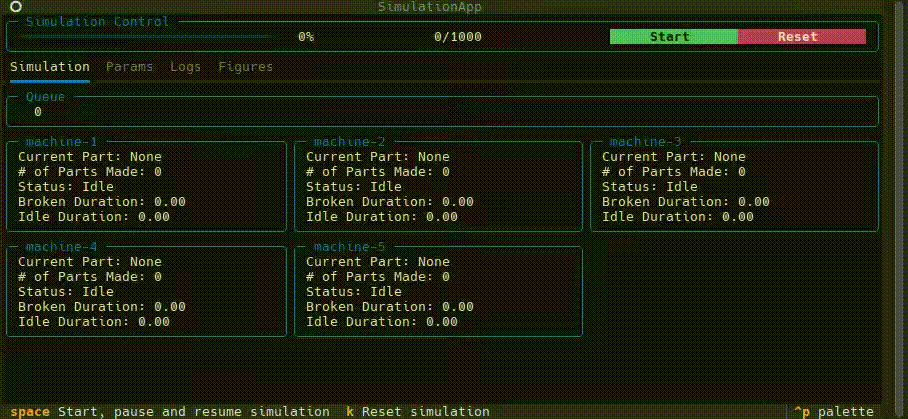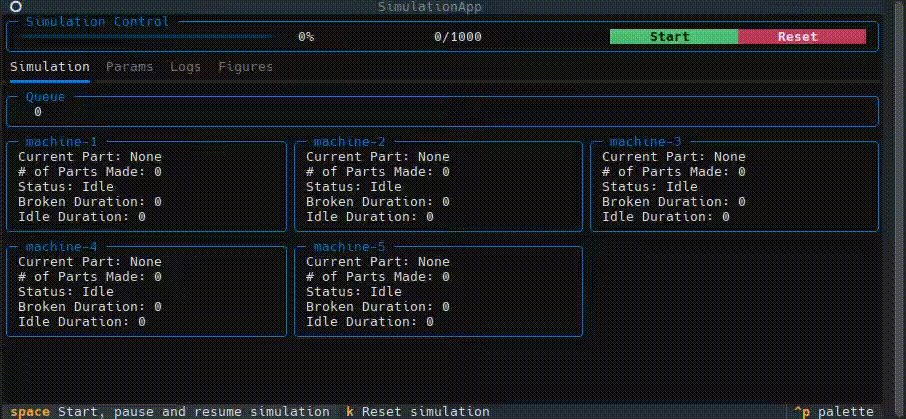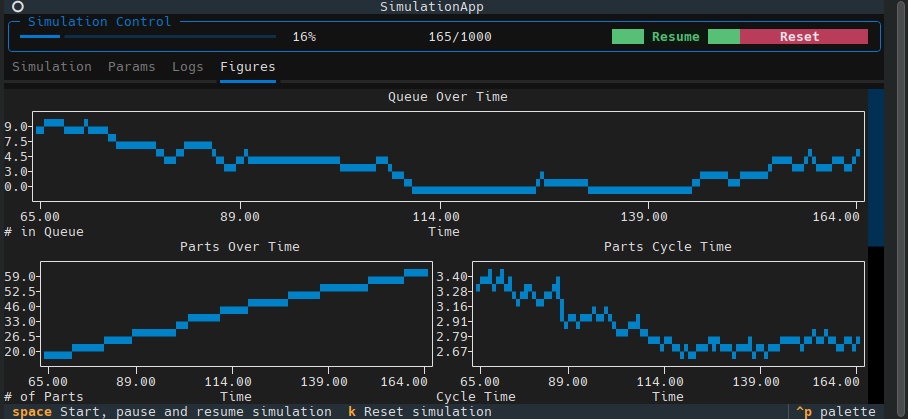 Example running machine shop simulation
Example running machine shop simulation
I recently started looking into discrete event simulation and found the barrier to entry was surprisingly low. Instead of learning dedicated software like Arena or Simio, you can use simpy, an open source Python framework for discrete event simulation.
simpy uses generator functions to model processes, enabling queues, resources, and random events. Simple models can use print statements for evaluation, but as complexity increases, understanding process flow and resource allocation becomes harder.
Metrics and visualizations help address these issues, but while simpy is great at handling processes, it leaves these other aspects to the user. Fortunately, the Python ecosystem provides plenty of solutions.
One solution for visualization is textual, a Python framework designed for rapid development of terminal user interfaces. Each simulation iteration can be plotted and visualized in the terminal. textual had a few more additional benefits:
- Using a terminal user interface keeps things simple. Visualizations or animations don’t need to be complex.
- Everything is in Python.
simpycan be called directly and type hints are shared. - Figures can be created using
textual-plotext, a widget for usingplotext, a terminal plotting library. - The app can be bundled to an executable using
pyinstaller, making it easy to distribute.
This proof of concept is the end result, the rest of the blog post explains how some of the key features were implemented. Many of these concepts could be applicable for visualizations or animations beyond simpy.
Links:
Animating Machines and Modifying Simulation Parameters
 Changing input parameters for machine shop simulation
Changing input parameters for machine shop simulation
Model parameters were handled using textual input widgets. If the simulation or model parameters is changed, the entire environment needs to be reset for it to apply. The performance impact of the simulation itself is very low compared to updating the animations and figures. The start time and step delay controls when the animation starts and how long to wait before continuing the simulation.
The animations for queue and machines used textual label widgets. Every iteration, the text would be updated using metrics log. The changes in color are from a class in the .tcss file.
class SimulationAnimation(VerticalScroll):
# ...
class MachineDisplay(Static):
def compose(self) -> ComposeResult:
self.border_title = self._content
self.active_part = Label("Current Part: None", id="part")
self.parts_made = Label("# of Parts Made: 0", id="parts_made")
self.machine_status = Label("Status: Idle", id="status")
self.broken_duration = Label("Broken Duration: 0", id="broken_duration")
self.idle_duration = Label("Idle Duration: 0", id="idle_duration")
yield self.active_part
yield self.parts_made
yield self.machine_status
yield self.broken_duration
yield self.idle_duration
def update_machine_metrics(self, machine_log: MachineMetrics):
self.active_part.update(f"Current Part: {machine_log['part_id']}")
self.parts_made.update(f"# of Parts Made: {machine_log['parts_made']}")
self.broken_duration.update(
f"Broken Duration: {machine_log['broken_duration']:.2f}"
)
self.idle_duration.update(
f"Idle Duration: {machine_log['idle_duration']:.2f}"
)
if machine_log["part_id"] is None:
self.remove_class("active")
self.machine_status.update("Status: Idle")
else:
self.add_class("active")
self.machine_status.update("Status: Active")
if machine_log["broken"]:
self.add_class("broken")
self.machine_status.update("Status: Broken")
else:
self.remove_class("broken")
# ...
def update_text(self, sim: MachineShop):
self.queue_display.update(sim.store.items.__len__())
for i, machine_display in enumerate(self.query(self.MachineDisplay)):
if len(sim.machine_metrics_log[i]) > 0:
machine_display.update_machine_metrics(sim.machine_metrics_log[i][-1])
else:
machine_display.update_machine_metrics(
{
"name": "",
"broken": False,
"broken_duration": 0,
"idle_duration": 0,
"part_id": None,
"parts_made": 0,
"time": 0,
}
)
def update_machine_grid(self, num: int):
self.query_one("#machine-grid").remove_children()
self.query_one("#machine-grid").mount_all(
[self.MachineDisplay(f"machine-{i + 1}") for i in range(num)]
)Initializing and Resetting Simulation
To run the simulation in textual, an async task is created using asyncio. This iterates through the model, updating the progress bar and sending an message at each time interval.
When the model is paused the task is stopped, if it is resumed, a new async task is created but uses the same environment. Although it was not implemented in this example, it should be possible to step through the simulation using env.step().
# snippet of initializing and running simulation
class SimulationControl(VerticalGroup):
sim_task: asyncio.Task | None
current_sim_time: float
simulation_control_params: SimulationControlParams
machine_shop_params: MachineShopParams
# ...
def init_simulation(self):
self.env = simpy.Environment()
self.sim = MachineShop(self.env, params=self.machine_shop_params)
self.current_sim_time = self.simulation_control_params.start_sim_time
self.paused = False
self.query_one(ProgressBar).update(
total=self.simulation_control_params.end_sim_time, progress=0
)
self.update_progress_label()
self.post_message(self.SimulationIteration(self.sim))
async def run_simulation(self, start, end):
for i in range(start, end, self.simulation_control_params.step_sim_time):
await asyncio.sleep(self.simulation_control_params.step_delay_time)
self.current_sim_time = i + self.simulation_control_params.step_sim_time
self.env.run(until=self.current_sim_time)
self.query_one(ProgressBar).update(progress=self.current_sim_time)
self.update_progress_label()
self.post_message(self.SimulationIteration(self.sim))
# ...Modifying the Machine Shop SimPy example
The discrete event simulation model used is from SimPy Machine Shop Example. The model was modified to be declared by a MachineShop class and to parameterize key inputs such as the number of machines. The Machine class was also modified to track additional metrics such as idle duration.
Metrics are logged using a process which appends the state of machines at a fixed time interval. Although this will miss events between time steps, it was the simplest implementation and sufficient for the visualizations.
class MachineShop:
def __init__(self, env: simpy.Environment, params: MachineShopParams) -> None:
self.env = env
self.repairman = simpy.PreemptiveResource(env, capacity=params.num_repairman)
self.store = MonitorStore(env)
self.machines = [
Machine(
env,
f"Machine_{i + 1}",
self.repairman,
self.store,
params.machine_params,
)
for i in range(params.num_machines)
]
self.metrics_log: list[MachineShopMetrics] = []
self.machine_metrics_log: list[list[MachineMetrics]] = [
[] for i in range(params.num_machines)
]
self.env.process(part_arrival(env, self.store, params.mean_time_to_arrive))
self.env.process(other_jobs(env, self.repairman, 30))
self.env.process(self.monitor_metrics(1))
def monitor_metrics(self, freq: float):
while True:
for i, machine in enumerate(self.machines):
# ...
self.metrics_log.append(
{
"time": self.env.now,
"queue_items": len(self.store.items),
"total_parts_made": total_parts_made,
"total_broken_duration": total_broken_duration,
"total_idle_duration": total_idle_duration,
"num_machine_broken": num_machine_broken,
"num_machine_active": num_machine_active,
}
)
yield self.env.timeout(freq)Creating Figures with plotext
 Figures created by textual-plotext of machine shop metrics
Figures created by textual-plotext of machine shop metrics
Figures were created using plotext and textual-plotext. Using the metrics log, the figure is cleared and redrawn each simulation iteration. Data is converted to polars for easier filtering.
class SimulationFigures(VerticalScroll):
class LinePlot(PlotextPlot):
def __init__(self, title: str, xlabel: str, ylabel: str):
self.title = title
self.xlabel = xlabel
self.ylabel = ylabel
super().__init__()
def on_mount(self):
self.plt.title(self.title)
self.plt.xlabel(self.xlabel)
self.plt.ylabel(self.ylabel)
def refresh_plot(self, *args: Sequence[Any]):
self.plt.clear_data()
self.plt.plot(*args)
self.plt.xticks(
[args[0][i] for i in np.linspace(0, len(args[0]) - 1, 5, dtype=int)],
[
f"{args[0][i]:5.2f}"
for i in np.linspace(0, len(args[0]) - 1, 5, dtype=int)
],
)
self.refresh()
def compose(self) -> ComposeResult:
# ...
self.queue_over_time = self.LinePlot(
title="Queue Over Time", xlabel="Time", ylabel="# in Queue"
)
# ...
with HorizontalGroup():
yield self.queue_over_time
# ...
def update_figures(self, sim: MachineShop):
if len(sim.metrics_log) < 1:
return
df = pl.DataFrame(sim.metrics_log).tail(100)
# ...
self.queue_over_time.refresh_plot(
df["time"].to_list(), df["queue_items"].to_list()
)
# ...